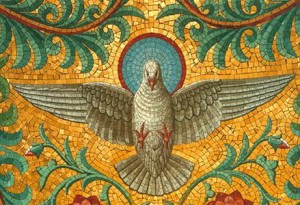 The Sacrifice of the Mass will be offered at 2:00 p.m. at St. Stanislaus Church. It is High Mass for Pentecost.
The Sacrifice of the Mass will be offered at 2:00 p.m. at St. Stanislaus Church. It is High Mass for Pentecost.
A Sermon for Ascension
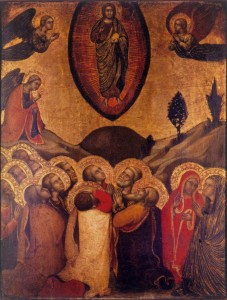 The Church celebrates this week the glorious feast of the Ascension of our Lord. The feast was celebrated on Thursday and today, so that as many people can participate as possible, we celebrate what is called the External Solemnity of the feast. It is important however not to loose sight of the fact that Our Lord, in fact, ascended on a Thursday, because it isn’t simply a random detail. On the one hand, it would seem that this feast marks the end of our Lord’s ministry, coming as it does at the end of his earthly life. (This is the symbolism of the Paschal Candle, which since Easter has burned as a sign of Christ’s teaching presence after the Resurrection among his disciples during the 40 days of Easter, which we rather dramatically extinguish after the Gospel) However, at the Ascension our Lord’s ministry actually reaches its culmination rather than its conclusion; Christ ascends on a Thursday, because it was on Thursday, at the Last Supper, that he instituted both the new priesthood and the new sacrifice: the Holy Eucharist; On Ascension Thursday, we see most clearly that Christ, a priest according to the Order of Melchizedec, now serves as mankind’s high priest before the Father in heaven. The Epistle to the Hebrews goes so far as to say that Christ “now lives to make intercession for us” (Heb. 7:25). The very way that Jesus ascended into heaven speaks to this mystery.
The Church celebrates this week the glorious feast of the Ascension of our Lord. The feast was celebrated on Thursday and today, so that as many people can participate as possible, we celebrate what is called the External Solemnity of the feast. It is important however not to loose sight of the fact that Our Lord, in fact, ascended on a Thursday, because it isn’t simply a random detail. On the one hand, it would seem that this feast marks the end of our Lord’s ministry, coming as it does at the end of his earthly life. (This is the symbolism of the Paschal Candle, which since Easter has burned as a sign of Christ’s teaching presence after the Resurrection among his disciples during the 40 days of Easter, which we rather dramatically extinguish after the Gospel) However, at the Ascension our Lord’s ministry actually reaches its culmination rather than its conclusion; Christ ascends on a Thursday, because it was on Thursday, at the Last Supper, that he instituted both the new priesthood and the new sacrifice: the Holy Eucharist; On Ascension Thursday, we see most clearly that Christ, a priest according to the Order of Melchizedec, now serves as mankind’s high priest before the Father in heaven. The Epistle to the Hebrews goes so far as to say that Christ “now lives to make intercession for us” (Heb. 7:25). The very way that Jesus ascended into heaven speaks to this mystery.
In St Luke’s account of the Ascension we read: “Then he led them out as far as Bethany, and lifting up his hands he blessed them, he parted with them, and was carried up into heaven.” (Luke 24. 52). Blessing was something familiar to every first century Jew. Each day at morning and evening, as commanded in the Law of Moses, the Jewish priests celebrated the tamid, or “perpetual offering” that we read about in the Book of Exodus (Ex. 29:38-41). One group of priests placed a lamb, bread, and wine on the altar as another group of priests led the people in reciting the Ten Commandments and the Shema, followed by the singing of the psalm designated for that day of the week. The tamid concluded with the priests gathering on the steps of the Holy Place, extending their arms out toward the people and invoking the blessing the Lord entrusted to Moses and Aaron: “The LORD bless you and keep you: The LORD make his face to shine upon you, and be gracious to you: The LORD lift up his countenance upon you, and give you peace.” (Num. 6:24-26). (This is why during the time of Divine Service, no woman or layman is permitted in the sanctuary. Boys are the exception as they, like the prophet Samuel before them, are allowed to serve the priests at their duty at the altar).
When the apostles and other disciples saw Jesus begin to ascend into heaven, in the very act of blessing them, they understood that he was “climbing the steps” of the true Holy Place. Only one Jewish priest was allowed to enter the Holy of Holies at the time of the tamid, to burn incense before God’s earthly throne room, the Holy of Holies. And the only person who could enter the Holy of Holies was the high priest, and he did so only once a year on the Feast of Yom Kippur. When the apostles saw Jesus disappear into a “cloud,” an Old Testament symbol of God’s presence (Acts 1:9; Ex. 13:31-32, 24:16-18; Num. 9:15-23), they understood that Jesus had entered into the true Holy of Holies, the reality to which the Temple and the earthly Holy of Holies were but a symbol and a pre-figurement (Ex. 25:9, 40; Heb. 8:5).
The worship of the Old Covenant — the Temple and its many sacrifices — find their fulfillment in Christ’s priesthood: his Death, Resurrection, and Ascension (Heb. 10:1-7). Jesus continues to offer himself to the Father, in his humanity, just as he has from all eternity in his divinity. The Epistle to the Hebrews and the Book of Revelation show Jesus, the Lamb of God, making the true perpetual offering to the Father — himself, through the five glorious wounds of his Passion (Heb. 7:25, 9:24; Rev. 5:6-14). Jesus draws all of heaven, the angels and saints, and indeed us as well, into this great heavenly liturgy, causing them to offer themselves through, with, and in him (Rev. 4:6-5:14).
This is the same liturgy that breaks through to earth, upon our altars, in the Holy Mass, where the sacrifice of Calvary is renewed through the ministry of priests. Moreover, through the sacrament of Holy Orders, Christ presides, in persona Christi, in the person of his priests. As the fulfillment of Israel’s tamid, the bread and wine we offer are indeed trans-substantiated into the very Lamb, himself, body, soul and divinity. We receive Christ himself in Holy Communion, the same Christ who bodily entered into the glory of the Father. Our lives are thus com-penetrated by his and every part united to his sacrifice to the Father (1 Cor. 10:16-18; Rom. 12:1). And when our priests pronounce the blessing over us before sending us forth, (which is why the blessing at the traditional Mass is given at the altar steps by the way) it is Christ who blesses — the same Christ who blessed the apostles before sending them out to convert the world.
We now prepare to celebrate the great gift of the Holy Spirit to us, which Christ promised at his Ascension, the Spirit of Truth who leads us into all truth, so that we too may take our part in converting the world. To fully receive that blessing — the Pentecostal grace Christ poured out upon the infant Church — we should dispose ourselves in the same way they did — faithful prayer and meditation upon Scripture, in the company of the Blessed Mother (Luke 24:49; Acts 1:14-15). These are very holy days, and indeed busy ones, but we should strive to recall the greater mysteries and then to live them as fully as possible. In Christ even something as unimportant as a Thursday takes on new meaning in our lives.
R. Dom Bede Price, monk of St Louis Abbey
Sermon for the Ascension 2016
Rector, Oratory of Ss. Gregory and Augustine
Saint Stanislaus
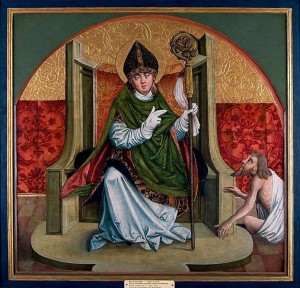 We find on the sanctoral calendar of the Extraordinary Form of the Mass (EF) holds today as the feast day of Saint Stanislaus, bishop and martyr.
We find on the sanctoral calendar of the Extraordinary Form of the Mass (EF) holds today as the feast day of Saint Stanislaus, bishop and martyr.
The EF is offered weekly and holy days at the New Haven Church bearing the patronage of today’s saint and it is fitting that his spiritual biography is offered for our consideration.
For your reflection here is an edited biography:
Saint Stanislaus (1030-1079) was born in answer to prayer, when his parents were advanced in age. Out of gratitude they educated him for the Church. When his parents died, he sold their vast properties and gave the price to the poor. He was ordained, and being a holy priest, soon afterwards became a Canon of the Cracow cathedral.
It was necessary to have recourse to the Pope to have him accept the see of Cracow when it became vacant. But the bishop of Cracow’s virtues increased with his dignity and obligations; Saint Stanislaus donned a hair shirt, which he wore until he died. He had a list drawn up of every poor person of the city, and gave orders to his servants never to refuse anything to anyone.
Boleslaus II was at that time King of Poland; he was a prince of good disposition, but spoilt by a long series of victories and successes. After many acts of lust and cruelty, he outraged the whole kingdom by carrying off the wife of one of his nobles. Against this public scandal the chaste and gentle bishop alone raised his voice. Having commended the matter to God, he went to the palace and openly rebuked the king for his crime against God and his subjects, and threatened to excommunicate him if he persisted in his sin. Boleslaus, with the intention of irrevocably ruining the bishop’s good reputation, suborned the nephews of a man named Paul who had recently died, to swear that their uncle had never been paid for land which the bishop had bought for the Church. Saint Stanislaus stood fearlessly before the king’s tribunal, though all his frightened witnesses forsook him, and guaranteed to bring the dead man to witness in his favor within three days.
On the third day, after many prayers and tears, he raised the dead man to life and led him in his grave-clothes before the king, where Paul testified that the bishop had reimbursed him fully for the terrain he had sold. He was then taken back to the grave, where he lay down and again relapsed into his former state, before a large number of witnesses.
Boleslaus for a while made a show of a better life. Soon, however, he returned to the most scandalous excesses, and the bishop, finding all remonstrance useless, pronounced the sentence of excommunication. In defiance of the censure, on May 8, 1079, the king went to a chapel where Saint Stanislaus was saying Mass and commanded three groups of soldiers in succession to slay him at the altar. Each in turn came out, saying he had been alarmed by a light from heaven. At this the king himself rushed in and slew with his own hand the Saint at the altar during the Holy Sacrifice.
The Pope placed the kingdom of Poland under interdict, excommunicated the king and declared his royalty null and void. Boleslaus repented, took refuge in another country for a time, then set out dressed as a pilgrim for Rome. On the way he knocked on a monastery door to ask for an alms, then decided to enter there anonymously, and was received. He spent seven years there as a Benedictine lay brother, rendering every humble service to the monks, patiently bearing rude treatment. Only on his deathbed did he identify himself, taking out his royal ring which he had concealed until then. He had spent hours praying before a statue of Our Lady in the chapel, by which we may conclude that the Mother of God had obtained for him the grace of conversion and a happy death. His body remains in the church of the same monastery of Ossiach.
Saint Stanislaus was canonized by Pope Innocent IV in 1253.
Reflection. The safest correction of vice is the Christian’s blameless life. Yet there are times when silence would make us answerable for the sins of others. At such times let us, in the name of God, rebuke the offender without fear.
Les Petits Bollandistes: Vies des Saints, by Msgr. Paul Guérin (Bloud et Barral: Paris, 1882), Vol. 5; Little Pictorial Lives of the Saints, a compilation based on Butler’s Lives of the Saints and other sources by John Gilmary Shea (Benziger Brothers: New York, 1894).
Novena to the Holy Spirit
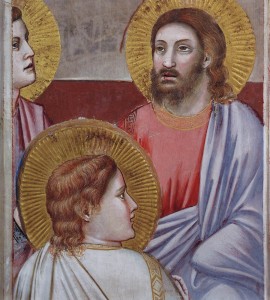 Beginning today, we need to make the petition to the Holy Spirit through a Novena asking that the Holy Spirit to bestow onus His seven gifts and the twelve fruits. The seven gifts of the Spirit: “wisdom, understanding, counsel, fortitude, knowledge, piety, and fear of the Lord. They belong in their fullness to Christ, Son of David” (Catechism, 1831).
Beginning today, we need to make the petition to the Holy Spirit through a Novena asking that the Holy Spirit to bestow onus His seven gifts and the twelve fruits. The seven gifts of the Spirit: “wisdom, understanding, counsel, fortitude, knowledge, piety, and fear of the Lord. They belong in their fullness to Christ, Son of David” (Catechism, 1831).
And, “The [12] fruits of the Spirit are perfections that the Holy Spirit forms in us as the first fruits of eternal glory. The tradition of the Church lists twelve of them: ‘charity, joy, peace, patience, kindness, goodness, generosity, gentleness, faithfulness, modesty, self-control, chastity’” (Catechism, 1832).
The prayers:
ACT OF CONSECRATION TO THE HOLY SPIRIT
On my knees before the great multitude of heavenly witnesses I offer myself, soul and body, to You, Eternal Spirit of God. I adore the brightness of Your purity, the unerring keenness of Your justice and the might of Your love. You are the Strength and Light of my soul. In You I live and move and am. I desire never to grieve You by unfaithfulness to grace and I pray with all my heart to be kept from the smallest sin against You. Mercifully guard my every thought and grant that I may always watch for Your light and listen to Your voice and follow Your gracious inspirations. I cling to You and give myself to You and ask You by Your compassion to watch over me in my weakness. Holding the pierced Feet of Jesus and looking at His Five Wounds and trusting in His Precious Blood and adoring his opened Side and stricken Heart, I implore You, Adorable Spirit, Helper of my infirmity, so to keep me in Your grace that I may never sin against You. Give me grace, O Holy Ghost, Spirit of the Father and the Son to say to You always and everywhere, “Speak, Lord, for Your servant hearth.” Amen.
PRAYER FOR THE SEVEN GIFTS OF THE HOLY SPIRIT
Christ Jesus, before ascending into heaven, You promised to send the Holy Spirit to Your apostles and disciples.
Grant that the same Spirit may perfect in our lives the work of Your grace and love.
Grant us the Spirit of Fear Of The Lord that we may be filled with a loving reverence toward You.
the Spirit of Piety that we may find peace and fulfillment in the service of God while serving others;
the Spirit of Fortitude that we may bear our cross with You and, with courage, overcome the obstacles that interfere with our salvation;
the Spirit of Knowledge that we may know You and know ourselves and grow in holiness;
the Spirit of Understanding to enlighten our minds with the light of Your truth;
the Spirit of Counsel that we may choose the surest way of doing Your will, seeking first the Kingdom;
Grant us the Spirit of Wisdom that we may aspire to the things that last forever; Teach us to be Your faithful disciples and animate us in every way with Your Spirit. Amen.
Solemnity of the Ascension
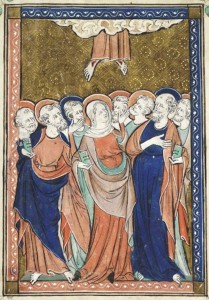 Low Mass will be offered today at 5:30 p.m. at St. Stanislaus Church, New Haven.
Low Mass will be offered today at 5:30 p.m. at St. Stanislaus Church, New Haven.
Consider a reflection on the Ascension of the Lord from St. Augustine:
“Today our Lord Jesus Christ ascended into heaven; let our hearts ascend with him. Listen to the words of the Apostle: ‘If you have risen with Christ, set your hearts on the things that are above where Christ is, seated at the right hand of God; seek the things that are above, not the things that are on earth.’ For just as he remained with us even after his Ascension, so we too are already in heaven with him, even though what is promised us has not yet been fulfilled in our bodies.”
